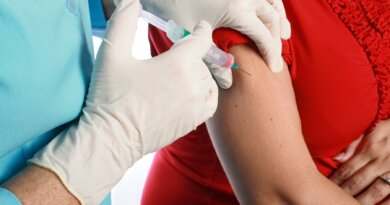Post-Breast Cancer Pregnancy Rate Boosted by Egg Freezing: Study
Jan. 23, 2024 – Kasey Vaillancourt and her husband were trying to get pregnant when she was diagnosed with breast cancer at age 36. Her oncologist told her she may not be able to safely carry a pregnancy due to the risk of her cancer coming back. Vaillancourt and her husband used a fertility clinic to create and freeze embryos, and they started researching surrogacy, possibly with Vaillancourt’s sister carrying the pregnancy.
Amid the abrupt turn in her family planning vision, Vaillancourt had a rare complication during egg retrieval where her belly and lungs became filled with fluid that later had to be drained during a hospital stay. Three days later, she had surgery to remove both of her breasts, and went on to do 12 rounds of a course of chemotherapy that has a history of damaging women’s fertility.
“The thought of possibly not being able to have kids was disheartening for both me and my husband,” said Vaillancourt, whose desire to be a mother was particularly fueled by becoming an aunt and seeing her sister’s mother-daughter relationship. “We didn’t know what this diagnosis meant. Are we going to be able to have a family? Being older as well, it’s like your clock is running out, or whatever the cliché saying is.”
Then, Vaillancourt read about a study about the safety of pregnancy after breast cancer called the POSITIVE Trial. After asking her oncologist to pull it up during an appointment, they agreed she could try for a baby. The couple used in vitro fertilization because, when her specialist “did the scans of my ovaries, she said, ‘I’m so glad you did this preservation because your ovaries are quiet,’” recalled Vaillancourt, who is now 39 years old.
This past May, her daughter Mae Vaillancourt was born.
Now, a second set of results from the same study show more good news for young women who want to become pregnant after being treated for breast cancer. Among the 497 women in the latest analysis, all of whom were under age 43 and had early-stage, hormone-sensitive breast cancer, 74% got pregnant during a planned pause from long-term treatment that helps prevent the cancer from recurring.
Along with the hope-inducing success rate, the new findings showed there was no significantly increased risk of recurrence among women who had fertility preservation before cancer treatment or who used assisted reproductive methods like in vitro fertilization, or IVF.
The results are important because more women are being diagnosed with breast cancer during their reproductive years. One estimate shows that among 30-year-old women, 1 in 204 will be diagnosed with breast cancer. Among 40-year-olds, 1 in 65 will be diagnosed. Researchers have been racing to examine whether not just pregnancy, but also fertility and reproductive medicine, affect the future risks of breast cancer patients because many breast cancers are sensitive to hormones like estrogen that spike during pregnancy or when using reproductive technologies.
A separate study also published last month showed that women with breast cancer who carry certain genes that raise their odds of the disease, known as BRCA mutations, also do not have a heightened risk of breast cancer recurrence after pregnancy, and the mothers and babies had no unusual safety risks.
The POSITIVE Trial, Part 2
These new research findings provide even more assurance about the safety of pregnancy after breast cancer, and offer guidance on what might increase the chances of having a baby after treatments like chemotherapy that may damage a woman’s fertility.
A year ago, the landmark initial findings of the POSITIVE Trial showed that women with hormone-sensitive breast cancer could safely take a 2-year break from protective treatments in order to try to become pregnant. The new secondary results from POSITIVE examined how the often hormone-heavy processes of preserving a woman’s eggs or using techniques like embryo transfer after IVF affect the odds of a woman’s cancer coming back.
One key new finding was that there was no significant increase in recurrence rates for women who had a process called ovarian stimulation for cryopreservation (when the ovaries are treated with medications to produce eggs, which are then frozen for later use), compared to women who didn’t. The recurrence rate within 3 years for both groups was around 9%. Ovarian stimulation typically happens before a woman’s eggs are harvested, after which they’re frozen or used to create embryos.
Another major finding showed that age was the only significant predictor of how quickly women in the study got pregnant. Timing is key because the women only had 2 years to pause their protective treatments while trying to get pregnant as a part of the study. The results showed that:
- Among women under age 35, 64% got pregnant within 1 year, and 80% got pregnant within 2 years.
- Among women ages 40 to 42 years old, 38% got pregnant within 1 year, and 50% got pregnant within 2 years.
The researchers looked at many other things that they suspected might impact how quickly women in the study would become pregnant, including when the women’s periods returned after treatment, whether they were treated with chemotherapy, and whether they’d had a baby before.
“These were things that we did not find at all had any impact. It was only age – the younger the patient, the shorter the time to become pregnant,” said Hatem A. Azim Jr., MD, PhD, who presented the findings at the San Antonio Breast Cancer Symposium last month.
The researchers looked at the many paths toward pregnancy of people in the study, including preservation techniques done at the time of their cancer diagnosis, as well as assisted reproduction techniques done when trying to get pregnant later, like transfer of recently created embryos or embryos that had been created, frozen, and then stored at the time of diagnosis.
Women who had cryopreserved embryo transfer had more than double the success rate of getting pregnant, compared to women in the study who didn’t use any assisted reproductive methods.
“One question could be, shall we offer assisted reproduction or [egg] or embryo preservation for women, and obviously the short answer is, this would be great,” Azim said. “Particularly when it comes to [egg] or embryo cryopreservation, this would be great so that we can kind of guarantee, to a great extent, fertility in the future.”
Retrieving Eggs Before Treating Cancer
For anyone facing a cancer diagnosis, the slew of tests, treatment decisions, and appointments can fill both the person’s headspace and calendar. For at least a decade, the standard of care for young women with breast cancer has been to advise them that treatment could damage their fertility, and they should be referred to a reproduction specialist for a consultation.
POSITIVE Trial researchers emphasize how important it is for the study results to become widely known, because some oncologists are still advising their patients that pregnancy isn’t safe.
Breast cancer treatment can easily last the rest of a young woman’s reproductive years. Some treatments that reduce the chance of recurrence are taken for up to a decade. With many women delaying having children, the window for starting or completing a family amid a breast cancer diagnosis can become very small, and the odds of a successful and safe pregnancy become worse as a woman ages.
Kristen Johannessen, DO, raced to get her eggs preserved before starting treatment for breast cancer in 2022. She was just 8 months into her new job in Williamsburg, VA, after completing training as a doctor. Already in her mid-30s, she knew she wanted to do fertility preservation.
“The office that I went to locally for my oncologist, they couldn’t offer me anything locally here. Most women here are post-menopausal,” she said.
She had to cold-call fertility clinics and scrambled to find one that could fit her in before she started chemotherapy, which would be followed by a double mastectomy.
Johannessen had little savings and a pile of student loans from medical school, so she put the approximately $14,000 cost of fertility preservation on credit cards. She spent hours researching complex financial assistance programs for cancer patients, one of which offered a medication discount for a fertility drug that was on backorder for months. Instead of paying for an alternative drug recommended by her doctor, program officials told her she had to wait until the backordered one came back in stock. Since she had chemotherapy and surgery coming up, she charged the readily available drug to her credit card.
Johannessen is currently about a year away from the time period considered safe for her to pause her preventive medications for 2 years while she tries to get pregnant. In the meantime, she’s paying $1,000 a year to store her frozen eggs. She knows that there’s a chance those eggs won’t lead to a successful pregnancy, and she may need to have more retrieved for more pregnancy attempts. But the latest data from the POSITIVE Trial makes her feel more comfortable about doing that if needed, she said.
“Looking at the data and seeing that not only is it appearing to be safe for me to undergo a pause from my medication, but also safe to do fertility medications once again and go through the process of that, I feel like it opened a new door to more options,” said Johannessen, who turns 37 at the end of January. “Through this process, you feel like doors just keep closing, and it’s nice to feel like one finally opened.”
Is Fertility Preservation Accessible?
Facing a short 24-month window to try to get pregnant leads some women to skip trying to get pregnant the old-fashioned way, which medical professionals call the “spontaneous” method. Many young breast cancer survivors move straight to assisted reproductive technologies (ART). In the POSITIVE Trial, which only included women who wanted to get pregnant, half of them had fertility preservation at the time of diagnosis, and 43% of the women used at least one ART method, such as embryo transfer.
The costs are staggering, typically topping well over $10,000 for preservation before treatment, and ART costs at least another $15,000. Most insurance plans don’t cover preservation or ART.
Just getting that reproduction consultation that professional medical organizations say should be recommended for all young cancer patients might be out of reach for many people. (Vaillancourt, whose baby was born in May, said she had to pay $350 upfront just to secure a consultation appointment.)
At the University of Texas’ MD Anderson Cancer Center, the consultation is now part of every young breast cancer patient’s first set of appointments, said Jennifer Keating Litton, MD, MHCM, a professor of breast medical oncology at the center. But she noted that it’s rare to have a reproductive endocrinologist on staff in an oncology department.
“Having that reproductive endocrinology and having the ability to freeze eggs is just not available to everyone at that time. A lot of times, that’s [an] out-of-pocket-expense on top of everything else going on, or I have some patients tell me they’re feeling so overwhelmed because they’re dealing with cancer and chemo and surgery, that they kind of put that to the side,” Litton said. “But for me, the take-home of that paper was there was a significant portion of women who underwent some sort of reproductive technology after the whole treatment and still had improved results, and still we were not seeing the safety signals.”
She cautioned that the follow-up period among women in the study was just 3 years and said she is hopeful that the safety findings will hold as the researchers continue to monitor the women as part of the research. Litton also stressed that the best time for young breast cancer patients to get a reproductive consultation is before the start of treatment.
There’s no formal measure of how many young breast cancer patients are actually advised to seek a reproductive consultation before starting treatment, and it’s also not known how many simply can’t afford it or can’t afford fertility preservation.
There is a movement calling for fertility preservation to be covered by insurance, and since 2017, there have been laws passed by 16 states plus the District of Columbia regarding fertility preservation, according to the Alliance for Fertility Preservation. In some ways, the efforts are similar to those that resulted in the federal law passed in 1998 requiring most insurance plans that cover mastectomies to also cover breast reconstruction.
Patients who contact the Alliance for Fertility Preservation are typically looking for where to go for a consultation, or looking for resources to help them pay for fertility preservation services, said Executive Director Joyce Reinecke, JD.
“There is a hesitancy to really describe services and offer services to someone when they really have no means to pay for those services. This is what I’m hearing from the oncologists that are a part of our team – that there is a reluctance to discuss these services in a complete way, particularly for women, because they are so much more expensive than for men,” Reinecke said. “So we think insurance coverage would address the financial barrier directly, and it would also facilitate referrals for services.”
But there’s also a trend nationwide for awareness about fertility considerations among women and among employers. Large employers like tech companies that compete for talent have made headlines for offering egg freezing benefits as a recruitment tool.
Beth Kirkpatrick was diagnosed with breast cancer at 39 years old, and got the results on New Year’s Eve in 2020. But back when she was 36, she had her eggs frozen.
“It’s kind of trendy in New York nowadays. There are a lot of companies that offer this as part of their benefits package, like Google and Facebook will pay for your egg freezing, and because of that, especially in New York, there are clinics that have opened up that specialize in egg freezing only,” said Kirkpatrick, who is a Broadway performer living in New York City. “So traditionally, if you went to a fertility clinic to get your eggs frozen, you’re spending at least $15,000. But now, to make it kind of quick and easy, I went to a place called Extend Fertility, and they’re kind of popping up everywhere, and they specialize in egg freezing, so they’re a little bit more affordable.”
She said the environment of the clinic was developed by hospitality industry experts, and the vibe is “cool and fun and no stress.”
Kirkpatrick said more needs to be done by the public health sector to spread fertility knowledge for all women, not just breast cancer patients, especially amid decisions to delay starting a family in order to advance a career or first become more financially stable.
Kirkpatrick, who is single, has completed the required 2 years of protective hormone-suppressing therapy that reduces the risk of recurrence and is preparing to try for a pregnancy. She intends to become a single mom and use a sperm donor, who in this case happens to be a close friend from high school.
She has closely been following the POSITIVE Trial results, using them as a guide and a reassurance on her path toward motherhood.
“It’s emotionally very weird to take drugs like estrogen and progesterone, knowing that they were the drugs that fed my cancer,” Kirkpatrick said. “There’s something about having had cancer that’s always going to be in the back of your mind, especially having had it young. But I take heart in the fact that the trial tells us that statistically, this looks good, and science also tells us that mothers live longer than non-mothers … so I hope to live as long as I possibly can and take care of myself and take care of my child. It’s exciting.”



